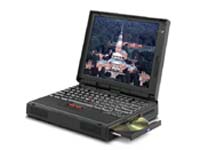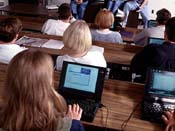Fall marks new stage in technology initiative
 If a Wake Forest University professor tells students this fall to get ready for an online quiz, there will be no question about whether they are equipped for the task. After all, everyone in the class will have a laptop computer provided by the university.
If a Wake Forest University professor tells students this fall to get ready for an online quiz, there will be no question about whether they are equipped for the task. After all, everyone in the class will have a laptop computer provided by the university.
“This fall semester, we reach our goal of getting a laptop into the hands of all Wake Forest undergraduates,” said Jay Dominick, assistant vice president for information systems. “When our freshmen pick up their computers on Aug. 18, they will be the fourth consecutive freshman class to get them since 1996, meaning everyone from freshmen to seniors have a computer now.”
Wake Forest began the computer distributions when it kicked off a comprehensive technology initiative that was part of a plan to enhance undergraduate education. The university has wired classrooms and residence halls for Internet access, installed multimedia equipment in classrooms, and introduced programs to support the integration of technology into teaching. Wake Forest students go online regularly to participate in group discussions, evaluate classmates’ writings, pose questions to professors, visit course Web sites, turn in assignments, and search databases. They also use ThinkPads to conduct lab experiments, write papers and explore CD-ROMS providing multimedia supplements to textbooks.
In some instances, faculty members are making their classes nearly “paperless.”
“I don’t even hand out paper copies of assignments, anymore,” said Christa L. Colyer, assistant professor of chemistry. She posts assignments, learning objectives, and other important class information on course Web sites, and often uses e-mail to send reminders and updates to students.
Ananda Mitra, assistant professor of communication, finds little use for paper in his classes, as well.
 “My classes are almost totally paperless,” explained Mitra, one of a growing number of Wake Forest faculty members finding new ways to use technology in teaching.
“My classes are almost totally paperless,” explained Mitra, one of a growing number of Wake Forest faculty members finding new ways to use technology in teaching.
In a seminar for freshmen, for instance, Mitra required his students to establish e-mail acquaintances with someone in South Asia. “That worked really well because it helped the students to understand better the culture and communication patterns in that part of the world,” explained Mitra, whose seminar was called, “Communication, Culture and South Asia.”
In a number of cases, faculty members report technology helps them get more out of class meetings.
Gordon McCray, an assistant professor in Wake Forest’s Calloway School of Business, finds he has more time now in the classroom to provide active learning experiences for his students. He gains that time by covering some class material in Web-based multimedia presentations he calls “CyberShows.” Created by McCray, who specializes in management information systems, the CyberShows run about 15 minutes.
By presenting more “real-world scenarios” in class, McCray said, he can help his students learn the subject-information systems-at a deeper level.
Technology also can play a part in helping students prepare better for class and lab sessions. For example, Colyer’s chemistry students often visit a special Web site that provides supplemental lab instructions. After reviewing the material, students take an online quiz. The results indicate to Colyer whether they, in fact, understand the information and are properly prepared for lab.
Faculty members, in a number of ways, are using technology to enable students to collaborate on projects. Associate Professor of English Anne Boyle, for example, assigns her first-semester composition students to work on a writing project with students at Acadia University in Canada. Working in small groups, her students collaborate in class on a short essay that is edited and evaluated online by their peers at Acadia. In their final form, the essays are published on the Web.
Collaboration takes a different form in economist David G. Brown’s freshman seminar, “The Economist’s Way of Thinking.” After lecturing on a particular topic, such as supply and demand, Brown concludes by asking students to use their computers in class to write their own definitions of the terms. A popular online messaging system quickly displays all answers on the same “page,” enabling the class to select a few that best define the terms.
“While checking to see how well the students are understanding the subject, I am also giving them the opportunity to explain a concept in their own words,” explained Brown, dean and vice president of the university’s International Center for Computer Enhanced Learning (ICCEL). Brown was Wake Forest’s provost when it launched its technology initiative.
This fall’s computer distribution occurs on Aug. 18 when freshmen arrive for a week of orientation. That afternoon, students will visit the Information Systems Building to pick up their ThinkPads and Lexmark color inkjet printers. Freshmen will attend one of two computer training sessions being held at various locations in the afternoon and evening on Aug. 20.
The same laptops will be distributed to juniors in the morning on Aug. 23 when they turn in computers they received as freshmen. Wake Forest students use laptops for two years before upgrading to new ones that they will eventually keep upon graduation. Juniors pick up their computers at the Information Systems Building, too.
Categories: Campus Life, Experiential Learning
Media Contact
Wake Forest News
media@wfu.edu
336.758.5237



